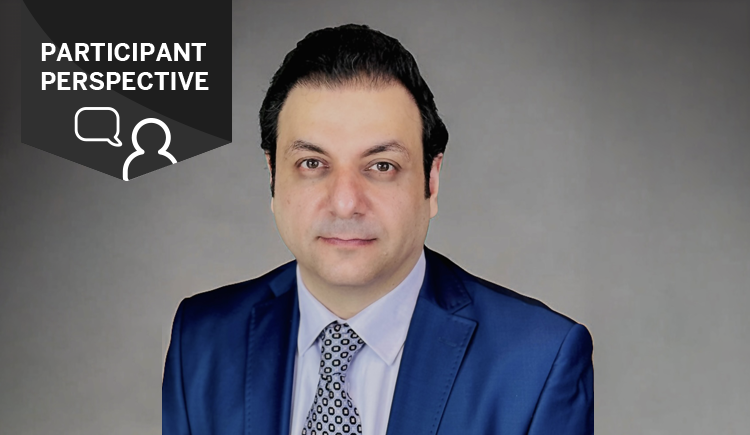
Information regarding COVID-19 has rapidly evolved. The content in this article provides a historical snapshot of events surrounding the date of posting.
Clinical leaders in a variety of health care settings are being challenged to find new ways to adapt their institution’s frameworks to meet the evolving demands and pressures that have arisen due to COVID-19. This makes it essential that they receive formal training in operational aspects of health care, while also understanding how to adapt to changing circumstances, so they can continue to help their organizations respond to current and future events.
At the Massachusetts General Hospital (MGH) Cancer Center, Vice President Mara Bloom, JD, MS, draws on principles of effective leadership to guide her organization through the many challenges it has faced since the COVID-19 pandemic began. As program director of Harvard Medical School’s Master in Clinical Service Operations, she also shares her extensive on-the-job experience with others in the field.
The Impact of COVID-19 on the Cancer Center’s Care Model
The MGH Cancer Center’s model incorporates the latest therapies and technologies in patient care while also developing innovations to help advance the oncology field.
“In the old world [pre-COVID-19], I thought about what patients want and what is most important to them. I also thought about how to improve quality and reduce costs,” Bloom explains. Now, in the midst of the pandemic, all of these goals still exist—but she points out that there is also an added layer to contend with, which requires seeing everything through a COVID lens.
Specifically, there are three main impacts caused by COVID-19 that are changing the way the Cancer Center does business. These include:
Delayed Diagnoses – Fears about contracting COVID-19 in the health care setting, coupled with greatly reduced availability for in-person visits, has led many people to put off routine screenings like mammograms and colonoscopies, as well as diagnostic tests and follow-up appointments. As a result, Bloom says that she hypothesizes that many cancers are being missed, and when they are diagnosed, the illness is at a more advanced stage. This means that they require more complicated treatments, often inpatient, and they are likely to have poorer outcomes. “This is the number one thing that keeps me up at night,” she confesses.
Reductions in Clinical Research – Another significant impact of COVID-19 is that the Cancer Center has had to turn off its clinical research to patients, with the exception of Phase 1 clinical trials for life-saving treatments that are critical for end-stage cancer. This has meant that many patients did not have access to important treatment options, and efforts to study the effectiveness are not progressing on schedule, which can hamper more widespread access to new treatments. Such delays can be detrimental to cancer patients. “Fortunately, we have been able to recover our research program by earmarking discretionary funds to resolve pandemic-related deficits, but other hospitals may not have the same resources,” she says.
Concerns about Cancer and COVID-19 – There is a serious concern about cancer patients getting COVID-19. “While people might wonder what this has to do with clinical operations, it’s important to remember that cancer is different from other specialties,” Bloom says. If you have cancer and are undergoing chemotherapy or radiation, your immune system may be weakened, which can make you more vulnerable to COVID-19. But most people with cancer—including those who test positive for the SARS-CoV-2 virus—must continue undergoing scheduled treatments to prevent their cancer from progressing.
Responding to the Current Realities
In order to address these—and so many other—challenges, Bloom and her colleagues are putting their leadership skills to work in new ways to help them rethink the business strategy and find innovative approaches to continue providing high-quality care. Here are some of the changes they have implemented through the Cancer Center, which are helping the organization meet patients’ evolving needs and concerns in the safest and most effective way.
Building Telehealth Capacity
One major change the Cancer Center has implemented has been moving as many patients as possible to telemedicine appointments. For the past seven years, MGH Cancer Center had a total of only about 300 telehealth visits among all providers per year, but now, with concerns about safety, they are seeing 5,000+ virtual care patients per week. “Moving forward, we want that to continue. As of October 2020, about 30 percent of MGH’s services were provided via virtual care. We hope to maintain that percentage in the future,” Bloom says, acknowledging that this will require perfecting some of the processes.
“A lot of the work that used to be handled by office staff has shifted to physicians and advanced practice providers, which is taking a lot of their time,” she points out, adding that staffing virtual care can also be difficult because it requires a different skill set. “It takes 1.5 times longer to set up a virtual visit than to schedule an in-person one. Also, staff don’t have the same face-to-face access to their providers to ask a quick question or clarification.”
Providing Services through Satellite Locations
Another way MGH has responded to the pandemic is by increasing its offerings through satellite locations. “In the past, we were always trying to get patients to go to our satellites [suburban locations], but they wanted to go to Boston. But with COVID-19, this has shifted and they are suddenly very eager to seek care [closer to home] in the community,” she says. To respond to this development, the organization is building its capacity in these suburban sites, and it is also exploring offering some routine services for cancer patients right in their homes so they don’t have to risk exposure to the virus. These conveniences can make it easier—and less expensive—to provide important and high-quality care.
Creating Sub-units for COVID-19 Patients
To address the vulnerabilities that exist with potential COVID-19 spread in the hospital setting, Bloom explains that MGH has created smaller units for COVID-19 positive patients within bigger specialty units. For instance, a cancer patient who is COVID-19 positive can receive chemotherapy in a special unit that prevents exposure to other, non-COVID-19 patients. Similar units are offered in different disciplines so everyone has access to important services without putting others at risk.
Adapting to Reduced Staffing
Staffing has also posed a challenge for much of the pandemic, she says. While patient flow originally declined steeply in the heart of the first wave of the virus; now MGH is back at 100-110 percent volume. Yet the units are not fully staffed, as not everyone has come back to work.
“A lot of parents are out of the workforce caring for their children who may be attending school remotely, or they may have gotten infected with COVID themselves and may be dealing with the side effects,” Bloom says. In addition, some clinicians working in the cancer center have been re-assigned to help with triaging patients with COVID-19. This means that the hospital has had to reallocate resources and rethink flow in order to deliver high-quality patient care while meeting the latest COVID-19 protocols even with limited staff. Additionally, as many other states are experiencing surges, it is hard to obtain travelers for nursing, which is a major concern.
Educating Patients about the Safety of MGH
Finances are another especially big concern right now at MGH, as they are at most health care organizations. Bloom points out that while cancer treatments including chemotherapy, radiation, and infusion rates didn’t erode significantly in COVID-19, surgery volume did drastically decline as elective procedures were stopped temporarily. And while the numbers have since improved, she points out that if the hospital isn’t getting new patients coming through the doors, revenues will still be down, creating a vicious cycle. “We have definitely seen a decline in international patients and patients from outside New England, given travel restrictions. One major factor that has deterred patients from coming to MGH and seeking medical care is fear of contracting COVID-19,” she says.
“Therefore, we needed enhanced communication and education to help people understand MGH is safe.” This is being done through TV and radio ads, website copy, and emails to consumers, letting everyone know what the organization is doing to ensure safety protocols are in place and encouraging people to continue to get their routine care and screenings. This is particularly important not only for the hospital’s bottom line but also because as Massachusetts prepares to deal with the next wave of the pandemic, Bloom stresses that it’s urgent that more people don’t put off screenings that potentially could save their lives.
Leading for Success
What all of these responses have in common is the commitment from the hospital leadership to bring together physicians, clinicians, nurses, allied health professionals, and administrators to work as a collaborative team to achieve common goals. Such strong leadership and vision has enabled them to deliver high-quality, value-based care, while also ensuring patient satisfaction and achieving the best outcomes during this difficult time. In fact, such a multi-faceted strategy has positioned MGH to weather COVID-19 and, at the same time, has helped it to be well positioned for whatever comes next as the pandemic continues to evolve.
Written by Lisa D. Ellis


